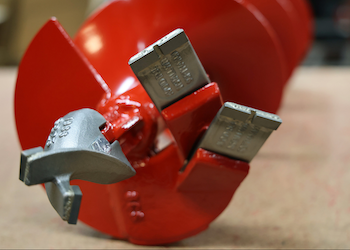Break up soil fast with the right augers and blades
Little Beaver shares some tips for matching boring equipment with soil type.
By Joe Haynes
 |
|
For projects in hard clay, frozen ground or compact rock, carbide blades quickly cut the materials into pieces. Plus, carbide blades stay sharp 10 to 20 times longer than steel tips. |
A powerful earth drill may have the torque a job requires, but without the correct cutting blade, productivity can suffer. Choosing the right augers, points and blades can unlock the door to faster digging and greater profits.
A less-than-perfect choice can leave operators trying to power slowly through clay, soft rock or compact soils. Using the wrong points or blades may also lead to faster wear and greater maintenance time and expenses.
Here’s a quick guide to choosing the best auger and blade for the job.
Determine auger strength
Start by selecting from a standard, carbide or heavy-duty auger. Soil conditions dictate the best option. Consider a standard auger for projects in soft soils and a carbide auger for frozen or compacted soils. For jobs in rocky soils, turn to heavy-duty augers, which feature more durable flighting and heavy-duty tooth and side cutting blades.
Choose the right size
Next, review the job specs to determine the diameter and depth of holes needed. Most manufacturers offer multiple auger diameters in varying lengths. Jobs that require deeper holes may also use an auger extension. Be sure to choose an earth drill model that matches the job. As the auger diameter increases, more power is needed from the drill.
Select points and blades
As with auger type, the right point or blade depends on the soil. For drilling in loamy soils or areas with few rocks, some manufacturers offer standard points and blades made of cold-rolled steel that feature a hard surfacing on the edges to quickly break up soil. For projects in hard clay, frozen ground or compact rock, carbide and chisel point blades are the ideal tip to quickly cut the materials into pieces. Plus, carbide blades stay sharp 10 to 20 times longer than steel tips.
Decide on uptime
When it’s time to connect the auger, point or blade, the easier option, the better. Some manufacturers offer snap-on augers and extensions. The convenient spring-loaded snap button makes attaching each fast because other tools aren’t required. When it comes to points and blades, some are designed to connect to the auger with two easy-to-remove steel bolts. When pairing blades with smaller-diameter augers — 1-1/2, 2 or 3 inches — the operator can simply screw or pin them on. These simple processes save valuable time on the job compared to alternative options on the market.
For the best ROI, consider quality, as well. Points and blades should easily handle more than 100 holes before requiring maintenance. Reversible blades are a good option because they can be flipped over for a new edge. These last twice as long than single-sided blades. Once both sides have worn, simply replace the blade rather than the entire auger for greater cost savings.
Editor’s note: Joe Haynes,is president at Little Beaver,a manufacturer of quality, safe and productive drilling equipment for three generations.











